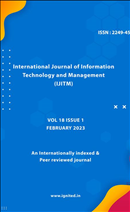Developing Wireless Communication Technique for Usage in IoT Applications
Main Article Content
Authors
Abstract
The Internet of Things (IoT) is another registering worldview that imagines standard ordinary articles being changed into significant items. In view of its benefits over wired advancements, like simpler arrangement, less expensive structures, compact help, flexibility, and straightforwardness of association, remote innovations will be the best option for interfacing IoT gadgets. There are assortments of remote advances that can be utilized for IoT; these innovations cover a wide scope of distances, from a couple of centimeters to numerous kilometers. The Internet Engineering Task Force (IETF) introduced the 6LowPAN convention in this article, and the ZigBee association set up the ZigBee convention over the low-power IEEE802.15.4 standard. Sensors are gathered in remote sensor networks applications to illuminate sensor centers. Commonly, battery power is utilized to drive these center points. In IoT applications, these centers should keep going for quite a long time without waiting be re-energized. IoT helps with settling on choices in view of genuine information gathered from a colossal number of ordinary gadgets that have been improved with information through the expansion of detecting, handling, and correspondence capacities. Remote correspondence is for the most part utilized by IoT gadgets to speak with different gadgets.
Downloads
Article Details
Section
References
- F. Wang, L. Hu, J. Zhou, and K. Zhao (2015). “A survey from the perspective of evolutionary process in the Internet of Things,” International Journal of Distributed Sensor Networks, vol. 2015, pp. 1–9.
- Lin J-R, Talty T, Tonguz OK (2015) on the potential of bluetooth low energy technology for vehicular applications. IEEE Communication Mag 53: pp. 267–275.
- S.Wilson.The future of 3g:the case for decommissioning. [Online]. Available: http://www.analysysmason.com/3G-decommission-Oct2015.
- U.Raza, “From energy efficient to energy neutral wireless sensor networks,” Ph.D. dissertation, University of Trento, 2015.
- P.M.JohnBurns,SelcukKirtay,“Future use of licence exempt radio spectrum,” Plum Consulting, Tech.Rep., 2015.
- M. R. Palattella, M. Dohler, A. Grieco, G. Rizzo, J. Torsner, T. Engel, and L. Ladid, “Internet of things in the 5g era: Enablers, architecture, and business models,” IEEE Journal on Selected Areas in Communications, vol. 34, no. 3, pp. 510–527, March 2016.

